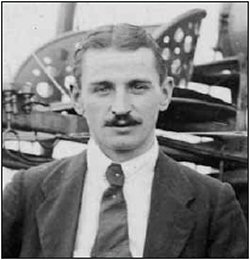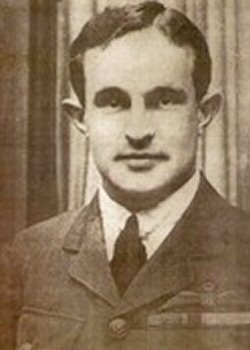South Africa was not left out of the interest in aviation that was occurring world wide after the flight by the Wright brothers.
John Weston, a civil engineer, began the construction of his own aeroplane in 1907 at Brandfort, in the Free State. He lacked an engine with enough power so he dismantled the aircraft and shipped it to France. It is possible that John Weston based his design on a Voisin. In France he fitted a Gnome rotary engine (50hp) and flew it successfully (in France) in 1910.
The first aircraft imported to South Africa was a Ralph S. Mansel glider that was built by Voisin Freres of Billancourt, France, arrived on 20 October 1908 in the Cape Town Docks aboard the “Varzin”.
On 18 December 1909 the Voisin single-sea engine powered pusher bi-plane of the visiting French aviator M. Albert Kimmerling was off-loaded from the “Kenilworth Castle” at East London.

Kimmerling, a Frenchman, made the first powered flight in South Africa in East London on 28 December 1909 over the Nahoon Racecourse. He managed to achieve an altitude of about 6 meters and a speed of approximately 30 miles per hour. At the end of February 1910 Kimmerling made three flights at Sydenham Hill, near Orange Grove. Thomas Thornton of Johannesburg was the first fare paying passenger when he paid £100 for a flight on 19 March 1910. Kimmerling was killed in an aircraft accident on 9 June 1912 in Mourmelon, France
The first aircraft designed, built and flown in this country was built by Alfred Louis Raison, based on the design that Louis Bleriot used to fly across the English Channel. Raison built the aircraft for a wealthy Johannesburg based timber merchant, Cecil Bredell. Bredell flew the aircraft on 2nd May 1911 at Highlands North, Johannesburg
On 16 June 1911 John Weston made the first flight in Kimberley establishing a South African non-stop flight record of eight-and-a-half minutes in his Weston-Farman biplane. His energy and drive led to the formation of the Aeronautical Society of South Africa in 1911. he was, however, prevented from ever establishing a flying school.
 Cecil Compton PatersonIt was the start of the John Weston Aviation Company of South Africa, which did much to popularise flight in the country by touring the main centres and offering flights to the public. One of his passengers at Turffontein Racecourse in Johannesburg was the actress Cressie Leonard who recalled, ‘I had dressed for the part in a close-fitting jersey costume, with no motor scarves to vex the propeller . . . The crowd roared and I could hear the distant clapping from the stand like rushing leaves.
Cecil Compton PatersonIt was the start of the John Weston Aviation Company of South Africa, which did much to popularise flight in the country by touring the main centres and offering flights to the public. One of his passengers at Turffontein Racecourse in Johannesburg was the actress Cressie Leonard who recalled, ‘I had dressed for the part in a close-fitting jersey costume, with no motor scarves to vex the propeller . . . The crowd roared and I could hear the distant clapping from the stand like rushing leaves.
The African Aviation Syndicate was formed and Captain Guy Livingston, Cecil Compton Paterson and Evelyn Frederick (Bok) Driver arrived in Cape Town in December 1911 for a series of demonstration flights. The syndicate had two aircraft – a Bleriot monoplane and a Paterson biplane.
The demonstrations were held in the Cape, where the first air mail was transported, in Johannesburg and then Kimberley. These flights brought aviation to public notice. A flying school was established at Alexandersfontein, but no pupils were trained, owing to the liquidation of the Syndicate in September 1912.
On 27 December 1911 the first airmail was carried by Bok Driver in his Bleriot monoplane. He travelled between Kenilworth Race Course and Oldham’s field near Muizenberg, a distance of approximately eight miles (almost 13 km.), The flying time was seven and a half minutes.
A group of prominent Kimberley businessmen bought up the assets of the Syndicate which a enabled Paterson to continue his flying activities as the Paterson Aviation Syndicate Ltd (Kimberley). He immediately negotiated the building of a hangar at Alexandersfontein and established his own flying school.

As a result of a visit by Brig Gen C F Beyers to England and Europe in August 1912 the government decided to start flying training for military purposes. In a Government Gazette published on 13 May 1913 citizens were invited to join the South African Aviation Corps (SAAC) as officer-aviators. Successful candidates would be paid 17 shillings 6 pence and an aircraft allowance of 5 shillings. Ten candidates were selected – John Clisdal, Gordon Shergold Creed, Edwin Cheere Emmett, Hopkins, Solomon, Basil Hobson Turner, M van Coller, Kennith Reid van der Spuy, Gerard Percy Wallace en Marthinus Steyn Williams.
The Union Government did not have any training facilities so negotiated with Paterson to have military pilots trained at his flying school. In July 1913 The Paterson Aviation Syndicate was registered and on 10 September General J C Smuts signed a Memorandum of Agreement with Paterson whereby the ten pupils were to be trained as pilots. The pilot testing would be supervised by the Aeronautical Society of South Africa as prescribed by and on behalf of
the Federation Aeronautique Internationale.

The training was on a Paterson bi-plane (No 36) with a 50 hp Gnome engine. Paterson appointed Edward Wallace Cheeseman as co-instructor. The school also accepted three private pupils. One of these was South Africa’s, and as a matter of fact, the first woman pilot in the whole of the African continent at the time, Ann Maria Bocciarelli, born in 1897 in Kimberley, the daughter of Sculptor Achille Bocciarelli. She obtained her pilots license in 1913, after the death of the co-instructor E W Cheeseman (11th October 1913).
This facility featured a runway cut from scrub so thorny that its single aircraft had to have its wheels protected by thick leather coverings to avoid punctures, and a corrugated-iron hangar that also served as a workshop where the trainees were taught to carry out aircraft maintenance. On the work benches were a spare engine, a few spare parts, a chest of tools, wire and canvas.

In an attempt to make the flying as safe as possible flying was limited to the early morning and late afternoon in wind still conditions. Early in the training Paterson and K R van der Spuy crashed. The aircraft was written off but luckily there were no injuries. A new aircraft was built out of the wreckage of the original and training continued.
The new aircraft was involved in a second crash. E W Cheeseman was seriously injured and died in a Kimberley hospital a few days later. Paterson purchased a replacement aircraft from one of the private pupils so that training could continue. The training was comprehensive and tough with eight pupils qualifying in December.
After the pupils had left in early 1914, the Flying School at Alexandersfontein was abandoned due to the commencement of World War I, Paterson’s return to England. A replica of a Paterson biplane stands in the Paterson Museum near the Kimberley airport.
They continued their training at Tempe and six were appointed as Lieutenants at the end of April 1914. These were Creed, Emmett, Turner, Van der Spuy, Wallace and Williams. These officers were sent to England under the command of Captain (temp) Wallace to complete their training with the Royal Flying Corps (RFC) at the Central Flying School at Upavon (Salisbury Plain), where five of the original ten pupils qualified for their certificates. They were in England when World War I was declared. Having recently qualified for their wings, they had immediately applied for permission to proceed to France for service in the RFC Their applications were successful and they joined two of the first four squadrons which were mobilised. They were to participate in the first aerial reconnaissance and artillery spotting missions over France during the closing months of 1914

In January 1915 the South African pilots were appointed in the Permanent Force an recalled to the Union to help man the SAAC established on 29 January 1915 for service in German South West Africa. On 6 May 1915 the SAAC went into action when K R van der Spuy (later Major General, CBE, MC) flew a reconnaissance sortie at Walvis Bay. The SAAC had access to six Henri Farman F-27 and two BE2C aircraft and provided air support of General Botha’s forces. The aircraft were used for reconnaissance patrols to keep Gen Botha informed of the enemy’s movements and positions. The Farmans also carried out a number of bombing missions.
After the German South West Africa campaign, the majority of the SAAC pilots volunteered for further service in England, where they were to form the nucleus of 26 (South African) Squadron (Sqn) of the RFC. This unit was dispatched to East Africa in December 1915 to carry out reconnaissance, bombing and communication missions in support of Gen Smuts’ forces.
In addition to those that served in 26 Squadron, a number of South Africans served as volunteers in other RFC squadrons in the course of the World War I. This was mainly due to the success of the recruitment drive of Major Allister Miller . Between 1916 and 1917 he persuaded approximately 2 450 South Africans to enlist with the RFC. These recruits became known as “Millers’s Boys”.

A number of South Africans pilots excelled in the war, the most famous of these were Maj Allister Miller, Capt Andrew Weatherby Beauchamp-Proctor, Capt Helperus Andrias. (Pierre) van Ryneveld, Maj Arthur E. Harris, Capt C J (Boetie) Venter and Capt Sam Kinkead. For a list of South African Aces – see The Aerodrome Site
30 enemy aircraft, Boetie Venter (22 aircraft) Douglas John Bell (20 aircraft) and Sir Hugh W. Saunders (19 aircraft). Capt Kinkead, Lt Col K R van der Spuy and Lt Col Pierre van Ryneveld also served in Russia. van der Spuy was taken prisoner and only released in 1920.
At the end of hostilities in 1918, 26 Squadron was eventually recalled to England and disbanded in 1918. The British Government offered aircraft to each of their Dominions to allow them to start their own Air Forces. South African received a total of 113 aircraft. These aircraft were used to form the South African Air Force at a new base close to Pretoria on the farm Zwartkops. In June 1920 Sir Pierre Van Ryneveld was promoted to Lt Colonel and appointed to the Instructional and Administrative staff of the Union Defence Force, back-dated to 1st February 1920. This date, in the absence of any official date is taken as the birth date of the SAAF.
In 1919, The Daily Mail offered a prize of 10,000 Pounds Sterling (about 300 000 Pounds in today’s terms) for the first successful non-stop flight across the Atlantic. This was followed by a further 10,000 Pound offer made by the Australian Prime Minister, Billy Hughes, for the first flight to Australia. Not to be outdone, the South African Government offered a similar prize for the first flight to the Cape.
